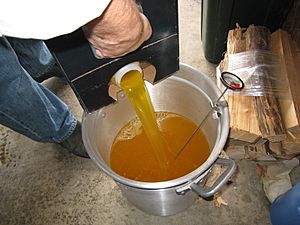Peanut oil facts for kids
Peanut oil, also known as groundnut oil or arachis oil, is a vegetable oil derived from peanuts. The oil usually has a mild or neutral flavor but, if made with roasted peanuts, has a stronger peanut flavor and aroma. It is often used in American, Chinese, Indian, African and Southeast Asian cuisine, both for general cooking, and in the case of roasted oil, for added flavor. Peanut oil has a high smoke point relative to many other cooking oils, so it is commonly used for frying foods.
History
Due to war shortages of other oils, use of readily available peanut oil increased in the United States during World War II.
Production
| Country | Production, 2018 (tonnes) |
|||
|---|---|---|---|---|
| 1 | 1,821,000 | |||
| 2 | 1,540,976 | |||
| 3 | 364,100 | |||
| 4 | 252,465 | |||
| 5 | 177,800 | |||
| 6 | 175,900 | |||
| 7 | 110,000 | |||
| 8 | 102,700 | |||
| 9 | 97,000 | |||
| 10 | 70,218 | |||
| 11 | 64,000 | |||
| 12 | 63,600 | |||
| Source : FAOSTAT | ||||
Uses
Unrefined peanut oil is used as a flavorant for dishes akin to sesame oil. Refined peanut oil is commonly used for frying volume batches of foods like French fries and has a smoke point of 450 °F/232 °C.
Biodiesel
At the 1900 Paris Exhibition, the Otto Company, at the request of the French Government, demonstrated that peanut oil could be used as a source of fuel for the diesel engine; this was one of the earliest demonstrations of biodiesel technology.
Other uses
Peanut oil, as with other vegetable oils, can be used to make soap by the process of saponification. Peanut oil is safe for use as a massage oil.
Composition
Its major component fatty acids are oleic acid (46.8% as olein), linoleic acid (33.4% as linolein), and palmitic acid (10.0% as palmitin). The oil also contains some stearic acid, arachidic acid, behenic acid, lignoceric acid and other fatty acids.
Nutritional content
| Nutritional value per 100 g (3.5 oz) | |
|---|---|
| Energy | 3,699 kJ (884 kcal) |
|
0 g
|
|
|
100 g
|
|
| Saturated | 17 g |
| Monounsaturated | 46 g |
| Polyunsaturated | 32 g |
|
Protein
|
0 g
|
| Vitamins | Quantity
%DV†
|
| Vitamin E |
105%
15.7 mg |
| Minerals | Quantity
%DV†
|
| Zinc |
0%
0.01 mg |
| Other constituents | Quantity |
| Cholesterol | 0 mg |
| Selenium | 0.0 mcg |
|
Fat percentage can vary.
|
|
| †Percentages estimated using US recommendations for adults. | |
Peanut oil is 17% saturated fat, 46% monounsaturated fat, and 32% polyunsaturated fat (table).
| Type of fat | Total fat (g) | Saturated fat (g) | Monounsaturated fat (g) | Polyunsaturated fat (g) | Smoke point |
|---|---|---|---|---|---|
| Butter | 80-88 | 43-48 | 15-19 | 2-3 | 150 °C (302 °F) |
| Canola oil | 100 | 6-7 | 62-64 | 24-26 | 205 °C (401 °F) |
| Coconut oil | 99 | 83 | 6 | 2 | 177 °C (351 °F) |
| Corn oil | 100 | 13-14 | 27-29 | 52-54 | 230 °C (446 °F) |
| Lard | 100 | 39 | 45 | 11 | 190 °C (374 °F) |
| Peanut oil | 100 | 17 | 46 | 32 | 225 °C (437 °F) |
| Olive oil | 100 | 13-19 | 59-74 | 6-16 | 190 °C (374 °F) |
| Rice bran oil | 100 | 25 | 38 | 37 | 250 °C (482 °F) |
| Soybean oil | 100 | 15 | 22 | 57-58 | 257 °C (495 °F) |
| Suet | 94 | 52 | 32 | 3 | 200 °C (392 °F) |
| Ghee | 99 | 62 | 29 | 4 | 204 °C (399 °F) |
| Sunflower oil | 100 | 10 | 20 | 66 | 225 °C (437 °F) |
| Sunflower oil (high oleic) | 100 | 12 | 84 | 4 | |
| Vegetable shortening | 100 | 25 | 41 | 28 | 165 °C (329 °F) |
See also
 In Spanish: Aceite de cacahuete para niños
In Spanish: Aceite de cacahuete para niños


